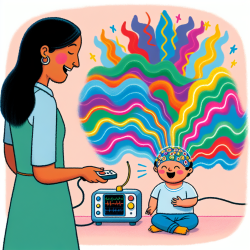Introduction
In the realm of speech-language pathology, understanding the nuances of semantic processing can significantly enhance therapeutic outcomes. A recent systematic review titled Semantic Processing in Healthy Aging and Alzheimer’s Disease: A Systematic Review of the N400 Differences provides critical insights into how semantic processing varies across different populations, including healthy aging individuals and those with Alzheimer's Disease (AD). This blog explores the implications of these findings for speech therapists and encourages further research to optimize therapeutic strategies.
Understanding Semantic Processing and N400
Semantic processing refers to the brain's ability to understand and integrate word meanings. The N400 component, an event-related potential (ERP) observed through EEG, is a key marker of semantic processing. Differences in N400 amplitude and latency provide insights into how effectively individuals process semantic information.
Key Findings from the Review
- Healthy Aging: The review found that while semantic knowledge tends to increase with age, the ability to process this information (semantic processing) may decline. This is reflected in decreased accuracy and increased response times in semantic tasks among older adults compared to younger ones.
- Alzheimer’s Disease: Individuals with AD showed more pronounced deficits in semantic processing, with smaller N400 effect amplitudes compared to age-matched controls. This suggests that semantic deficits in AD may be more specific and severe than those seen in normal aging.
- Early Detection: Establishing norms for healthy aging could aid in the early detection of AD by identifying deviations in semantic processing performance and N400 measures.
Implications for Speech Therapy
For speech therapists, these findings underscore the importance of tailoring interventions to address the specific semantic processing challenges faced by different populations. Here are some practical applications:
- Targeted Interventions: Develop therapy activities that enhance semantic processing by focusing on tasks that improve accuracy and reduce response times in older adults.
- Early Screening: Incorporate N400 measures into assessments to identify early signs of semantic processing decline, potentially indicating the onset of AD.
- Continuous Research: Encourage ongoing research to refine our understanding of semantic processing changes across the lifespan and in pathological conditions like AD.
Encouraging Further Research
The systematic review highlights the need for more research to establish comprehensive norms for semantic processing across different age groups and cognitive conditions. Speech therapists can contribute to this body of knowledge by participating in studies and applying evidence-based practices in their clinical work.
Conclusion
Understanding the intricacies of semantic processing and the role of the N400 component can significantly enhance the effectiveness of speech therapy interventions. By leveraging these insights, therapists can better support individuals with varying cognitive profiles, ultimately leading to improved communication outcomes.
To read the original research paper, please follow this link: Semantic Processing in Healthy Aging and Alzheimer’s Disease: A Systematic Review of the N400 Differences.










